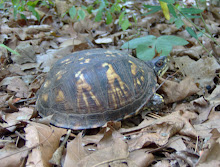
Another semester is about to start and I'll be TAing some introductory biology labs, getting started on my thesis project and taking a some geography classes. Since its late, I thought I'd pull something out of the ol' archive. I had this image made into notecards, which are available, just email me. The original is 22"X30"--a "larger-than-life" format for an animal surrounded by larger-than-life stories. The model for this drawing was a decent-sized gravid female that my brother plucked off the road just before she could step into four lanes of heavy traffic. I happened to be visiting that weekend so he brought her home in the back of his pickup to show me, and in hope that I'd know what to do. Evidently, she was trying to make her way from her home in the reservoir to some remembered or imagined nesting area across the road. When we returned to the place, all I could see there was a gas station and a parking lot, maybe she had her sights on something, some wild place beyond the gas station. The chances of her making it across were nil, nevermind that she'd then have to return to the reservoir or travel overland to another body of water. There were once days when these animals could do that. Not just days, but millions of years, and the impulse to do so remains. One thing people often exclaim when seeing one of these creatures is, "They look so prehistoric!" They do. Snapping turtles have looked like snapping turtles for a mind-bogglingly long time. A recent molecular study has shown a surprising lack of genetic divergence across the species' range. Its not really been explained yet why this is. I'd have to look at the paper again for the details. Their impressive ability to travel overland, at least before their habitats became so fragmented, doesn't seem sufficient by itself to explain this. Another mystery from a common animal that is becoming less and less common.
Their larger-than-life reputation has a dark side for them. A lot of people seem to think it justifies mistreating them. I stopped showing this image to any but a select few people for a while because of the number of gory snapper stories people insisted on telling me upon seeing it. The stories invariably ended badly for the snapper, and none of them were accidents. What made them think I wanted to hear their crap? I spent many hours carefully rendering the many different textures, and noticing how remarkably they contrasted with the eyes. The eyes of a snapping turtle are so beautiful--four tiny perfect compass points in each, and sparkling, and set into the massive head, the big inverted basin of a shell, the wrinkled and scaly skin. The whole animal is capable of disappearing or going unnoticed in a moment if in the right habitat. They know the use of motionlessness, and of resembling mud.
Its not inevitable that people react negatively to them. My nephew, who was about 9 months old at the time was delighted with her, watching her intently and waving his arms and giggling whenever she moved. He saw no need to conform to someone else's nonsense.
We debated what to do with her. Usually, if it is safe for you to do so, you should help a turtle across the road in the direction they were headed, as turtles are notoriously committed to their decisions, but in this case there didn't seem to be any nesting habitat for her to head for. Translocating turtles is problematic, because they need a habitat that they know in detail in order to survive, and because moving a sick animal (which may not even look sick at the time) could introduce a disease to a healthy population, as has happened with the desert tortoises and gopher tortoises. Removing them from their habitats is wrong and often illegal as well. In the end, we returned her to the reservoir and watched her swim off, kicking up a cloud of mud as she went, and hoped that she found another place to nest--one where she'd be able to make both the nesting and return journeys, where her round, white eggs, buried underground, would be warmed by the round, white sun, and unnoticed by predators, to hatch into minute versions of their mother and fathers, emerge from the ground, blink the soil from their eyes, and head for the water.




No comments:
Post a Comment